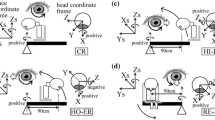Summary
Oculomotor control in man was investigated during passive, sinusoidal, whole-body rotation under a conflict between the vestibulo-ocular reflex (VOR) and the eye tracking system (ETS), as to the appropriate direction of compensatory eye movements. ETS predominated at stimulus frequencies below 0.8 Hz, and VOR above 1.5 Hz. In the intermediate frequency range the dominance repeatedly flipped between ETS and VOR, suggesting that the interaction of the two systems is not linear, but rather governed by a switch.
Similar content being viewed by others
References
Baarsma EA, Collewijn H (1974) Vestibulo-ocular and optokinetic reactions to rotation and their interaction in the rabbit. J Physiol (Lond) 238: 603–625
Barr CC, Schultheiss LW, Robinson DA (1976) Voluntary, nonvisual control of the human vestibulo-ocular reflex. Acta Otolaryngol 81: 365–375
Benson AJ, Barnes GR (1978) Vision during angular oscillation: the dynamic interaction of visual and vestibular mechanisms. Aviat Space Environ Med 49: 340–345
Collewijn H, Curio G, Grüsser O-J (1981) Interaction of the vestibulo-ocular reflex and sigma-optokinetic nystagmus in man. In: Fuchs AF, Becker W (eds) Progress in oculomotor research. Elsevier, Amsterdam
Fuchs AF, Kimm J (1975) Unit activity in vestibular nucleus of the alert monkey during horizontal angular acceleration and eye movements. J Neurophysiol 38: 1140–1161
Gonshor A, Melvill Jones G (1976) Extreme vestibulo-ocular adaptation induced by prolonged optical reversal of vision. J Phisiol (Lond) 256: 381–414
Keller EL, Kamath BY (1975) Characteristics of head rotation and eye movement related neurons in alert monkey vestibular nucleus. Brain Res 100: 182–187
Koenig E, Allum JHJ, Dichgans J (1978) Visual-vestibular interaction upon nystagmus slow phase velocity in man. Acta Otolaryngol 85: 397–410
Lisberger SG, Evinger C, Johanson GW, Fuchs AF (1981) Relationship between eye acceleration and retinal image velocity during foveal smooth pursuit in man and monkey. J Neurophysiol 46: 229–249
Oman CM, Bock OL, Huang J-K (1980) Visually induced self-motion sensation adapts rapidly to left-right visual reversal. Science 209: 706–708
Robinson DA (1977) Linear addition of optokinetic and vestibular signals in the vestibular nucleus. Exp Brain Res 447–450
Robinson DA (1982) A model of cancellation of the vestibuloocular reflex. In: Lennerstrand G, Keller EL, Zee DS (eds) Functional basis of ocular motility disorders. Pergamon Press, Oxford (in press)
Schmid R, Buizza A, Zambarbieri D (1980) A non-linear model for visual-vestibular interaction during body rotation in man. Biol Cybern 36: 143–151
Takahashi M, Uemura T, Fujishiro T (1980) Studies of the vestibulo-ocular reflex and visual-vestibular interactions during active head movements. Acta Otolaryngol 90: 115–124
Waespe W, Kenn V (1979) The velocity response of vestibular nucleus neurons during vestibular, visual, and combined angular acceleration. Exp Brain Res 37: 337–347
Author information
Authors and Affiliations
Additional information
Supported by grant Gr 161 from the Deutsche Forschungsgemeinschaft (DFG), and by DFG research fellowship Bo 649/1 to the author
Rights and permissions
About this article
Cite this article
Bock, O. Non-linear interaction of the vestibular and the eye tracking system in man. Exp Brain Res 47, 461–464 (1982). https://doi.org/10.1007/BF00239364
Received:
Accepted:
Issue Date:
DOI: https://doi.org/10.1007/BF00239364




